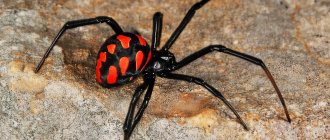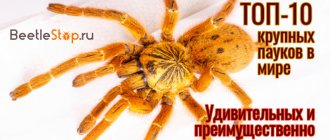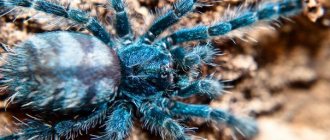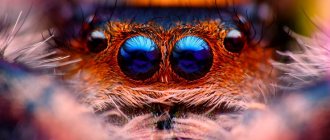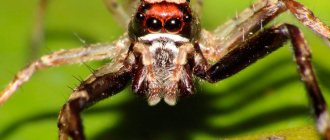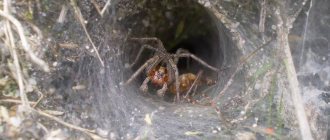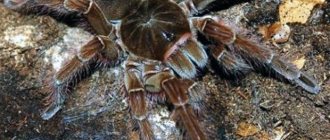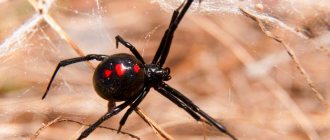Bagheera Kipling - an amazing herbivorous spider
In the entire history of spider research, a tropical spider whose diet consists of plant foods was discovered for the first time. The journal Current Biology published an article in which researcher Christopher Meehan reported: “This is the only precedent in the world for a spider to find and consume plant food, while it is the basis of its diet.”
All of the known 40 thousand species of spiders are predators; it is worth noting that some representatives can consume plant pollen or nectar, but only when the plant food enters the spider’s mouth during the processing of used web.
Kipling's Bagheera (Bagheera kiplingi).
Robert Curry, together with his colleagues from the University of Arizona, found that the diet of the spider Bagheera kiplingi (which was named after the famous writer and the character of his famous work) consists mainly of plant foods. These spiders live in tropical forests, they consume Belt bodies - miniature shoots on the leaves of tropical acacia.
Kipling's Bagheera is a strict vegetarian.
It is assumed that these bodies were formed in acacias in order to establish symbiosis with different types of ants, which actively protect trees from animals that feed on foliage. Ants live in trees and feed on Belt bodies, which are rich in nutrients.
Although there was previously an assumption that Kipling's Bagheera was a vegetarian, scientists were able to prove this only with the advent of technology that allows high-resolution recordings.
The spider lives in symbiosis with ants.
During field observations, it was found that the plant diet makes up 90 percent of the diet of tropical spiders of this species.
In addition, the researchers conducted a chemical analysis of the spiders’ bodies, from the results of which it became clear that the ratio of carbon and nitrogen in Bagheera Kipling’s body indicates their vegetarian diet.
The spider feeds on animal food in exceptional cases.
These spiders only occasionally consume fruit flies and ant larvae. At the same time, spiders react with lightning speed to the appearance of ants and immediately run away or move using their web. The authors of the article are of the opinion that Kipling's Bagheera has the smell of ants, so they can exist in the neighborhood of these insects.
This discovery was revolutionary in the theory of the evolution of species, since it shows that the symbiosis of two species can cause a third species to begin to use these properties, while not participating in the joint evolutionary process.
Kipling's Bagheera is named after the heroine of the famous author's story.
Kipling's Bagheera differs from other fellows not only in its unusual diet, but also in its ability to build nests. At the same time, several individuals live in the nests, and the males help care for the eggs and take part in raising the young. Such social relationships are an exception for other species of spiders. Most likely, Bagheera Kipling's spiders acquired this behavior during the transition from a carnivorous to a vegetarian lifestyle. The authors of the article will study this issue in more detail in the future.
If you find an error, please select a piece of text and press Ctrl+Enter.
“Herbivorous” gourmets discovered among spiders
Heliophanthus, spider of the jumping spider family
joaquinportela / flickr.com
Zoologists have discovered that spiders, which are traditionally considered predators, sometimes also eat plant foods. Journal of Arachnology talks about this.
.
Scientists from the University of Basel and Cardiff conducted a bibliographic study of spider behavior based on information obtained from the Thomson-Reuters database. In their study, they also included articles from the Internet that reported on the “herbivorous” habits of animals. In total, 95 articles were taken for the study, indicating that spiders feed on plants.
As a result, zoologists found that similar behavior was observed in spiders on all continents except Antarctica. In total, the ability to eat plant food was found in representatives of ten families, which included anifenid spiders, sac-web spiders and side-walking spiders. These spiders fed on a variety of plants: trees, shrubs, weeds, ferns, grass and orchids. In addition, zoologists divided “herbivorous” spiders into five groups according to “taste preferences”: those feeding on leaves, sucrose, pollen, seeds and spores.
The biggest lovers of plant food turned out to be jumping spiders ( Salticidae
).
Almost 60 percent of the messages concerned representatives of this particular family. According to scientists, jumping spiders chose more diverse types of food (nectar, juice, pollen) compared to other families of spiders. Scientists suggest that members of the family Salticidae
are predisposed to include plant foods in their diet.
The largest proportion of plant-eating spiders are reported to live on warm continents, where nectar secretion by plants is widespread, scientists note.
“The ability of spiders to obtain nutrients from plants expands the food supply of these animals; this may serve as a survival mechanism for them when insect shortages occur,” notes one of the study authors. However, scientists have yet to study exactly how plant foods affect the spiders' diet.
Spiders are an order of arthropods that number about 42 thousand modern and about 1.1 thousand fossil species.
They feed primarily on insects or other small animals, which they catch with the help of a web, after which they kill them with poison, inject digestive juices into them and suck out the resulting nutrient solution. Kristina Ulasovich
How much does a spider eat?
Feeding a house spider.
The amount of food per individual depends on the species, age, size and characteristics of the food.
It is believed that arthropods can live for about 30 days without food. But under normal conditions, the spider needs to feed every 7-10 days.
Depending on the type of predator, there may be several dietary preferences:
- eats only as much as needed;
- prepares food in reserve;
- eats everything, even to his own detriment.
Among the spiders there are greedy people. Some have the habit of eating everything until only one shell remains. It happens that they are so full that their belly begins to spread.
There's a Spider Who's Almost Completely Vegetarian
In a nutshell:
We think of spiders as vicious predators, injecting venom into their prey and sucking out the liquefied insides.
However, there is one species of jumping spider called Bagheera kiplings that feeds almost entirely on the nutrient-rich tips of leaves. Scientists are somewhat puzzled as to how this spider developed a vegetarian diet, or even how it manages to digest plant matter in the first place. [Please note that the above is actually a photograph of a different species of jumping spider, due to the rarity of photographs of Bagheera kiplinga.]
More details:
Even those who have not overtly suffered from arachnophobia often become nervous around the presence of spiders. This is thought to be an evolutionary trait, a “healthy fear.” While most spiders are capable of inflicting little more than a painful bite on us, the most dangerous species can be deadly and are best avoided completely. We view spiders as vicious, cold-blooded predators endowed with profound cunning. However, there is one type of spider that is not at all bloodthirsty.
Bagheera kiplingi, native to Mexico and Central America, is unique among the approximately 40,000 other known spider species in that it feeds almost entirely on herbivores. The name comes from Bagheera, the Black Panther from Rudyard Kipling's The Jungle Book. This is a bit of a misnomer, as this spider is not a hunter at all.
They are arboreal, typically living in flowering Mimosaceae trees. Their main food source is a cone at the end of tree leaves called the Beltian body. This structure is rich in fat, protein and sugar and is used to carry out a symbiotic relationship with the ants. The ants eat the Beltian's bodies and in turn drive away more destructive creatures. To share their food supply with aggressive ants, spiders are very fast and agile, dodging to grab some food and then running away at speed. Although Bagheera Kiplinga tends to carefully avoid these ants, it is not entirely herbivorous; it will occasionally chew ant larvae and devour other spiders during the dry season when their regular food supply is limited.
Spiders in the house: how to find the cause
Some people believe that spiders in the house are a harbinger of trouble. But there is another opinion - seeing a spider in the house is a sign of good or financial gain.
You can read about superstitions associated with spiders here.
There are two main reasons for the appearance of spiders in a person’s home:
- they become uncomfortable in the house, the weather deteriorates, and they look for a calmer and more comfortable place;
- there is enough food in the room to exist comfortably for a long period of time.
Distribution and lifestyle
The species Bagheera kiplingi is distributed in Mexico, Ecuador and Costa Rica. It lives mainly in tropical rainforests where acacias of the genus Vachellia grow. In order to protect themselves from the Pseudomyrmex ants living in their bark, these trees secrete Belt bodies, a special substance that appears on the blossoming young buds and serves as food for them. In gratitude, hardworking insects protect the generous acacia trees from many parasites.
Belt bodies also serve as the main food for spiders living on their branches and occupy up to 90% of the total diet. In addition to this, they feed on flower pollen and occasionally steal ant larvae, running away from angry pursuers on their long legs. They are very afraid of ants and diligently avoid direct contact with them, but they imitate them in every possible way. Simply put, they parasitize on workers, brazenly stealing the spoils that belong to them.
Young spiders are very similar in appearance to adult Pseudomyrmex individuals. This mimicry protects them well from insectivorous birds and possibly from the ants themselves. Spiders organize common nests, occupying one plant in hundreds of individuals and organizing entire armies of males to repel ant attacks. Females lay eggs all year round without being tied to any season.
There is an example of an evolutionary transition from unproductive hunting to more profitable gathering, which entailed social changes and even changed the intestinal microflora. Males began to pay more attention to raising and protecting their offspring, which indicates the complex structure of the spider community of vegetarians.
[custom_ads_shortcode2]
